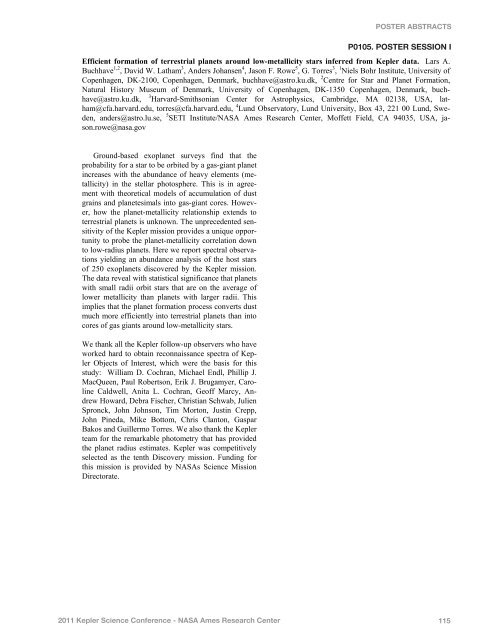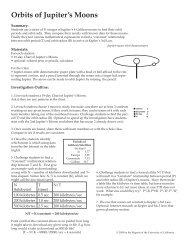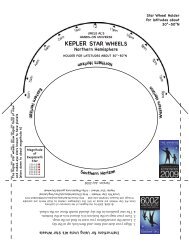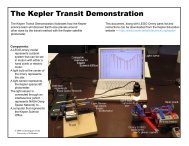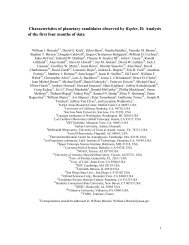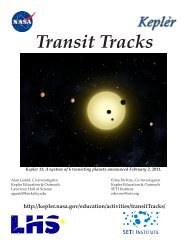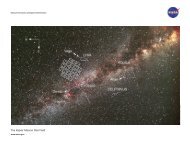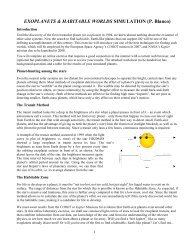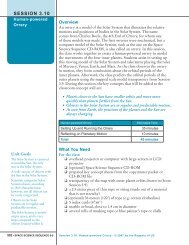POSTER ABSTRACTSP0104. POSTER SESSION IMeasuring the Rate of Non-Planetary Background Transit Events in <strong>Kepler</strong> Data. S. T. Bryson 1 , M. R. Haas 2 ,J. M. Jenkins 3 , C. J. Burke 4 , and D. A. Caldwell 5 , 1 MS 244-30 <strong>NASA</strong> Ames Research Center Moffett Field, CA94035 steve.bryson@nasa.gov, 2 <strong>NASA</strong> Ames Research Center, michael.r.haas@nasa.gov, 3 SETI Institute,jon.jenkins@nasa.gov, 4 SETI Institute, christopher.j.burke@nasa.gov, 5 SETI Institute, douglas.caldwell@nasa.gov.Introduction: The <strong>Kepler</strong> mission finds exoplanetsthrough the detection of transit signatures. However,transit-like signatures can be due to phenomenaother than exoplanets. One of the dominant sources ofsuch false-positive transit signatures is an eclipsingbinary nearly aligned with the observed target star,referred to as a Background Eclipsing Binary (BGEB).While eclipsing binaries in isolation generally haveeclipses that are much deeper than a planetary transit,dilution by the flux of the target star can reduce theapparent depth of the eclipse so it appears very similarto a planetary transit.The <strong>Kepler</strong> data analysis pipeline uses a variety ofmethods to detect BGEBs, primarily by detecting anoffset of the transit signal from the target star. Thismethod fails when the BGEB is very well aligned withthe target star. Therefore it is critical to know theprobability of an aligned BGEB when determining theconfidence that a transit signal is due to an exoplanetorbiting the target star. Available binary density models[1] provide an estimate of the expected backgroundbinary density, but these models have a high degree ofuncertainty because they are based on the observedbright binary population.We describe a direct measurement of the density ofeclipsing binary signals in the <strong>Kepler</strong> field of view thatwould appear as planetary transits if diluted by a foregroundtarget star. We expect that some of these signalsare due to extremely faint binary systems thatcannot be distinguished from the general stellar background.We do not attempt to characterize these binarysystems, as we are interested only in the density ofpossibly confounding BGEB signatures.The Observed Data: Starting in quarter 5 (Spring2010) a 36 x 60 pixel (143 x 239 arcsec) region (Fig.1) on each of the 80 active channels of the <strong>Kepler</strong> focalplane has been observed with the standard <strong>Kepler</strong> 30-minute long cadence. These regions contain relativelyfew bright stars. The size of these regions was dictatedby the number of pixels that became available whenfour channels of the <strong>Kepler</strong> focal plane failed in quarter4.These regions total 0.2% of the focal plane, comparedwith 6% of the focal plane observed in the planetarysearch. Eclipsing binary density models predictthat the number of BGEB signatures in each regionwill range from a few for channels towards the Galacticplane to less than one for channels away from theGalactic plane.Measuring the BGEB Signal Density: BGEBsignals will be detected by tiling each region withoverlapping 2x2 pixel apertures and searching theseapertures for eclipsing binary signatures using thestandard <strong>Kepler</strong> data analysis pipeline. This searchwill be part of standard <strong>Kepler</strong> processing [2] beginningin mid 2012. Preliminary searches are underwayand available results will be presented. The 2x2 tilingproduces about 130,000 targets to be searched.The use of 2x2 pixel apertures is driven by the desireto minimize background noise while still capturingthe flux of the BGEB in at least one aperture. We expectthat the resulting search will be complete to about<strong>Kepler</strong> magnitude Kp = 22. For comparison, Zodiacallight is about Kp = 20.This study will provide an estimate of the densityper square arc second of eclipsing binary signals thatwould appear planetary (have depth < 1%) when dilutedby a target star as a function of eclipse period anddepth. This estimate can be used to calibrate binarypopulation models.Several challenges arise in this study. Channelsaway from the Galactic plane are predicted to havefewer than 1 BGEB in each region, so our result willbe based on small statistics. We will discuss the completenessof our study, specifically the detectability ofvery dim BGEBs.We welcome collaborators in the analysis of thisbackground data. Formal collaborators will have accessto all background data.References: [1] Raghavan, D. et. Al. (2011) ApJ.,to appear. [2] Jenkins, J. J., et al. (2010) Proc. SPIE, Vol.7740, 77400D.Fig 1: All <strong>Kepler</strong> channels averaged together, showingthe BGEB search region as the shaded rectangle. Left:all 1024 x 1100 pixels per channel. Right: close-up ofthe BGEB search region.1142011 <strong>Kepler</strong> Science Conference - <strong>NASA</strong> Ames Research Center
POSTER ABSTRACTSP0105. POSTER SESSION IEfficient formation of terrestrial planets around low-metallicity stars inferred from <strong>Kepler</strong> data. Lars A.Buchhave 1,2 , David W. Latham 3 , Anders Johansen 4 , Jason F. Rowe 5 , G. Torres 3 , 1 Niels Bohr Institute, University ofCopenhagen, DK-2100, Copenhagen, Denmark, buchhave@astro.ku.dk, 2 Centre for Star and Planet Formation,Natural History Museum of Denmark, University of Copenhagen, DK-1350 Copenhagen, Denmark, buchhave@astro.ku.dk,3 Harvard-Smithsonian Center for Astrophysics, Cambridge, MA 02138, USA, latham@cfa.harvard.edu,torres@cfa.harvard.edu, 4 Lund Observatory, Lund University, Box 43, 221 00 Lund, Sweden,anders@astro.lu.se, 5 SETI Institute/<strong>NASA</strong> Ames Research Center, Moffett Field, CA 94035, USA, jason.rowe@nasa.govGround-based exoplanet surveys find that theprobability for a star to be orbited by a gas-giant planetincreases with the abundance of heavy elements (metallicity)in the stellar photosphere. This is in agreementwith theoretical models of accumulation of dustgrains and planetesimals into gas-giant cores. However,how the planet-metallicity relationship extends toterrestrial planets is unknown. The unprecedented sensitivityof the <strong>Kepler</strong> mission provides a unique opportunityto probe the planet-metallicity correlation downto low-radius planets. Here we report spectral observationsyielding an abundance analysis of the host starsof 250 exoplanets discovered by the <strong>Kepler</strong> mission.The data reveal with statistical significance that planetswith small radii orbit stars that are on the average oflower metallicity than planets with larger radii. Thisimplies that the planet formation process converts dustmuch more efficiently into terrestrial planets than intocores of gas giants around low-metallicity stars.We thank all the <strong>Kepler</strong> follow-up observers who haveworked hard to obtain reconnaissance spectra of <strong>Kepler</strong>Objects of Interest, which were the basis for thisstudy: William D. Cochran, Michael Endl, Phillip J.MacQueen, Paul Robertson, Erik J. Brugamyer, CarolineCaldwell, Anita L. Cochran, Geoff Marcy, AndrewHoward, Debra Fischer, Christian Schwab, JulienSpronck, John Johnson, Tim Morton, Justin Crepp,John Pineda, Mike Bottom, Chris Clanton, GasparBakos and Guillermo Torres. We also thank the <strong>Kepler</strong>team for the remarkable photometry that has providedthe planet radius estimates. <strong>Kepler</strong> was competitivelyselected as the tenth Discovery mission. Funding forthis mission is provided by <strong>NASA</strong>s Science MissionDirectorate.2011 <strong>Kepler</strong> Science Conference - <strong>NASA</strong> Ames Research Center 115


